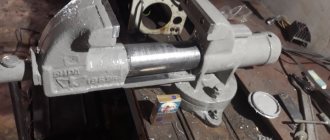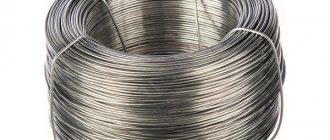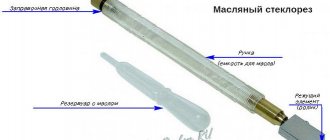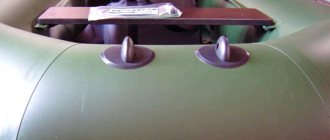Large-scale production, jewelry, repair, “garage” carpentry and metalworking crafts consist of processes for processing blanks of parts for a future product. Any careless movement can ruin the desired result, therefore, in addition to the golden hands of the master, correct fixation of the material is important, and a bench vice does an excellent job of this.
Video description
Bench vice.
Let's sort it out. Let's take a look. Let's compare. The device uses two steel jaws and a locking mechanism, with the help of which the distance between them is changed or fixed. Typically, one of the two parts is fixedly attached to the body, and the other moves so that the fastening is secure. The design of a vice for plumbing work includes the following components:
- The bed is a massive fixed support. It gives stability to the vice. In most cases, it is made of cast iron, but there are structures made of steel or duralumin.
- Jaws, one of which is fixedly fixed, and the other moves along the screw fastening. They are most often made of cast iron, but there are also those where high-strength plastic was used for manufacturing. The part that comes into contact with the part has a corrugated surface. This is necessary in order to increase grip strength.
- The lead screw passes through the jaws of the vice. The moving part moves along it. The movement is controlled using a handle located on the outside of the tool. This screw is made of high strength steel.
To make room for the part, the screw is rotated counterclockwise. To press it, twist it until it stops, turning it in the other direction. The moving part is located on the opposite side of the screw. In order to make the tool more functional, a small anvil is placed on it.
One type of machine vice Source vash.market
The design of most tools is described here, but there are also other options. In some cases, hydraulics may be used instead of a screw for clamping. In various models, two pairs of cheeks are used for more reliable fixation. There are tools where the movable jaw can be placed on the other side of the fixed one. Such models are called reversible.
When used, such a vice is held in the hands Source vash.market
How to make a vice from metal with your own hands: materials and sequence of work
Bench and milling vices are designed for working with metal, so a more reliable and stronger material will be required here. We are talking about durable steel or cast iron. At the same time, like wooden ones, you can make them yourself. The easiest way is to make a vice from a channel with your own hands. To do this you will need the following set of tools:
- welding machine;
- electric drill;
- grinder with a circle for cleaning;
- a square for correctly determining angles;
- drills of different sizes and diameters.
In addition, you will need the following materials and auxiliary tools for making a vice from a channel with your own hands:
The easiest way to make a bench vise is to make it yourself from a channel.
- blueprints;
- channel made of steel 6 mm thick;
- metal sheet with a thickness of 6 mm;
- corner size 70x70 or 50x50;
- a pin with a diameter of 16 mm, used as a clamping screw;
- bolts and nuts – 20 sets.
A pair of nuts into which the screw is screwed is not easy to make yourself; here it is best to use the services of a professional turner. The nut is welded to the channel as coaxially as possible. The ends of the channel should be covered using pieces of metal sheets; a hole must be made in the strip for the screw.
At the next stage, using a grinder, cut out two corners and a plate. The finished corners are fitted to the channel on both sides and covered with a piece of metal. Thus, a U-shaped structure is obtained, which is the basis of a hand-made vice from a channel.
To make the frame, you will need a sheet of metal 7-10 mm thick, in which four holes are drilled on each side, and also 6 holes are made on the U-shaped element. One nut is welded to the frame, and on the sides of it there are two metal stoppers. They also make their own jaws for a vice: they are cut out of steel. One part is welded immediately, and the second is attached to the moving part.
Materials used
Various materials can be used to make the tool:
- The most popular is cast iron. It ensures the strength and durability of the vice. Such devices are characterized by heavy weight and bulkiness.
- Recently, vices are increasingly made of steel. The more expensive and high-quality ones are made from high-strength, the rest are from ordinary varieties.
- The use of duralumin makes the tool lighter, but it loses in strength characteristics. The use of these materials in special areas - in jewelry, in the repair of electronic devices.
- Occasionally you can find devices made from wood. Typically, such tools find their use in carpentry workshops. An important advantage of such a vice is that when using them, there is no deformation of the parts. However, the screw that is present here is most often made of metal, although in some cases it can be made of wood.
Sometimes the surface of the cheeks is made of other materials. For this purpose, for example, non-ferrous metals and rubber can be used. The pads are made removable, which allows you to change them as they wear out.
To increase functionality, the tool may have an anvil Source vash.market
Tool dimensions and weight
Vices are widely used in processing various types of parts. Depending on their shape and size, you need to choose a vice. The most commonly used types of tools are:
- The small vice weighs 8 kg. Their sizes are 29 and 14 cm. The stroke of the sponges is 8 cm, their height is 5 cm.
- The weight of a medium-sized tool is 14 kg. Its length is 29.2 cm and its height is 18 cm. The jaws have a width of 7 and a stroke of 12.5 cm.
- The dimensions of the large vice are 45.8 and 22 cm, and the weight reaches 27 kg. The free stroke length of the jaws is 16, and the height is 9 cm.
There are also tools whose characteristics differ significantly from those presented here.
Angle vise allows you to hold parts together during processing Source vash.market
Pipe
Sparta 185705
Type of vice: pipe. The product is used for processing round-shaped parts, pipes, and rods. Strong fixation allows you to cope with operations such as threading or sawing workpieces.
| What material is the body made of? | steel |
| What material are sponges made of? | steel |
| Stroke indicator, mm | 89 |
| Weight, kg | 4,67 |
| Rotate function | No |
| Equipment | tool, box |
| Cost, rub. | 1939 |
Advantages and disadvantages
does not require special maintenance
There are plastic pads on the handle
structural strength
no significant shortcomings
Rekon 031003 30 mm
The pipe vice has a folding design. Thanks to the use of hardened steel for the manufacture of jaws, the service life of the product is long. The maximum diameter of the workpiece is 90 mm.
| Stroke indicator, mm | 100 |
| What material is the body made of? | cast iron |
| What are sponges made of? | steel |
| What is the width of the jaws, mm | 30 |
| Weight, kg | 8 |
| Size of landing grooves, mm | 15 |
| Rotate function | No |
| Equipment | tool, box |
| Cost, rub. | 9445 |
Advantages and disadvantages
Possibility to attach the vice to a tripod or workbench
strong fixation of the workpiece
high quality body and jaws
no rotation function
high price
Compression ratio
This parameter is one of the most important when choosing a wizard tool. It ensures reliable fixation and the inability to move the part during processing. The more massive products you have to work with, the more important this characteristic of the vice design is.
If the tool does not provide sufficient fixation force, then during operation the part may accidentally move, which will lead to a decrease in the quality of the corresponding operation.
Using a vice makes work more efficient Source moiinstrumentu.ru
Types of instruments
There are different types of vices that are designed to solve a variety of problems. The designs have features that need to be taken into account when choosing.
Screw models
They use a pressure screw that goes through the entire thickness of the tool. It is completely covered with threads, which have a trapezoidal cross-section. Fixation occurs using a screw located on the outside of the instrument. The clamp is carried out when it rotates clockwise.
Diagram of the vice design Source moiinstrumentu.ru
Quick clamping vice
Unlike screw models, the movable jaw is not firmly seated on the screw. It can be shifted slightly in the transverse direction at the request of the master. This part is spring-loaded and is usually pressed securely with a screw. When sheared, it can move freely along the screw.
This makes it convenient to move the movable sponge over a relatively large distance. This property will be useful if you need to quickly open the vice to place a relatively voluminous part there.
Quick release
In such a tool, the movable jaw easily moves along the axis. In this case, the clamping is carried out using special levers. The advantage of this design is the ability to quickly prepare for work.
Sectional image of prints Source moiinstrumentu.ru
Eccentric vice
They are a rotary mechanism, the pressure of which is adjusted using a retracted handle. When the part is fixed, reliable pressure is applied.
Pneumatic models
In design they resemble a standard design instrument. Additionally, a pneumatic power device is attached to the side opposite to the screw. Air pressure provides the required clamping force, reaching it within 2-3 seconds.
Hydraulic vice
They are connected to a hydraulic mechanism, which can be built-in or connected. These vices are commonly used in manufacturing plants. The use of hydraulics saves the technician’s effort and allows the work to be completed faster.
Almost every workshop should have a vice Source moiinstrumentu.ru
Homemade vice: machine design and manual model
A machine vice is a more precise version of the device for fixing parts. It is either completely devoid of play, or its run-up is the smallest. The vice is simply installed on the workbench. They differ in that they have a rotating mechanism.
The machine version has its own subtypes:
- stationary (with fixation perpendicular to the location of the vice);
- sinus, where the part is installed at an angle;
- multi-axis, in which the workpiece can rotate in different directions along the axis.
Machine-type vices provide strong fixation, which is extremely important when processing metal parts. They have a durable body and are coated with an anti-corrosion layer. The rigidity of the clamp ensures high precision work. At the same time, if the workpiece clamp is distorted, then marks will remain on it. For this purpose, you will need a foil gasket or you need to fix the part using only the upper part of the jaws.
On a note! Carpenter's vices, in comparison with other types of equipment, allow for better processing of parts made of soft materials, while large products can be worked in the same plane.
The price of industrially produced vices is quite high, so it is better to make them yourself.
The manual model is a portable vice of a compact shape that does not require stationary fixation on the base. They are designed for processing small workpieces and come in two types (based on design features):
- with jaws, screw and handles;
- A lever-type vice that resembles pliers with a locking mechanism.
These vices are used for precision work, as they have a minimum level of play. The tool is designed for working with profiles made of aluminum and metal tiles, and you can also clamp flat-shaped workpieces on them. Therefore, if you intend to process miniature parts, it is enough to purchase or make a hand vice with your own hands at home.
Purpose of the tool
Due to the wide variety of parts, you need to take into account that it will be convenient to use different types of tools for them. The design of a bench vice is standard. They are sometimes additionally equipped with a small anvil or pipe bender.
For small parts, a miniature version is used. Such a vice is convenient for home use or where you can work with small parts, for example, when repairing electronic equipment. These vices are portable. They do not use removable cheeks. Therefore, when working between the part and the pressing surface, the master places rubber or plastic gaskets.
This video talks about the best models of carpentry vices:
Video description
TOP-5.
The best bench vice. Machine vices are actually part of a particular machine. Usually special protrusions are provided for their fastening in the structure. Thanks to them, you can adjust the position of the fixed part in relation to the working element of the machine. This tool is usually made of steel.
A hand vice is two plates fastened together on one side with a metal bridge. The parts are clamped using a special screw. During operation, the vise with the part is held in the hand.
Carpentry is mounted on a workbench. They are made from steel or wooden parts. This type of vice is also called a carpenter's vice. One of their features is the use of large area sponges with a smooth surface.
Main types of bench vices
To satisfy all possible consumer demands, a huge number of various modifications of vices have been developed: from small manual ones to giant industrial ones. Vices are divided according to the following characteristics:
- By functional purpose (manual, carpentry, plumbing, machine tools, pipes, special purposes);
- By material (wooden, metal);
- By size (small, medium, large);
- By type of clamping mechanism (mechanical, pneumatic, hydraulic).
How to choose
When buying a vice, you need to clarify what kind of work they are needed to do. Accordingly, the appropriate type of tool can be determined. It is important to take into account the size of the parts being processed - it will affect what the dimensions of the tool should be.
Carpenter's vices are used to work with wooden parts Source moiinstrumentu.ru
We need to determine what the sponges should be like. In some cases, tools that can be replaced are better suited. You need to pay attention to the method of fastening the linings - the use of screws or rivets.
Globe vise allows you to change the angle of the part Source moiinstrumentu.ru
The best models of bench vices
The market can offer a large assortment of brands and models, which the buyer ultimately chooses based on his preferences and budget.
Options that have earned the most respect from consumers:
- Bench vice - WILTON WI21400, COBALT 246-012, BISON 32712-100;
- Carpenter's vice - WILTON WWV/175 65017EU, ZUBR EXPERT 32731-175;
- Pipe vise - RIDGID 25 40100 (1/8-4) 29674, ZUBR 32611-2 2438.











